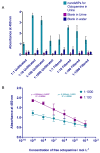Molecularly Imprinted Nanoparticles Assay (MINA) in Pseudo ELISA: An Alternative to Detect and Quantify Octopamine in Water and Human Urine Samples
- PMID: 31540212
- PMCID: PMC6780943
- DOI: 10.3390/polym11091497
Molecularly Imprinted Nanoparticles Assay (MINA) in Pseudo ELISA: An Alternative to Detect and Quantify Octopamine in Water and Human Urine Samples
Abstract
In 2004, octopamine was added to the list of drugs banned by the world anti-doping agency (WADA) and prohibited in any sport competition. This work aims to develop a new analytical method to detect octopamine in water and human urine samples. We proposed a pseudo-enzyme-linked immunosorbent assay (pseudo-ELISA) by replacing traditional monoclonal antibodies with molecularly imprinted polymer nanoparticles (nanoMIPs). NanoMIPs were synthesised by a solid-phase approach using a persulfate initiated polymerisation in water. Their performance was analysed in pseudo competitive ELISA based on the competition between free octopamine and octopamine-HRP conjugated. The final assay was able to detect octopamine in water within the range 1 nmol·L-1-0.1 mol·L-1 with a detection limit of 0.047 ± 0.00231 µg·mL-1 and in human urine samples within the range 1 nmol·L-1-0.0001 mol·L-1 with a detection limit of 0.059 ± 0.00281 µg·mL-1. In all experiments, nanoMIPs presented high affinity to the target molecules and almost no cross-reactivity with analogues of octopamine such as pseudophedrine or l-Tyrosine. Only slight interference was observed from the human urine matrix. The high affinity and specificity of nanoMIPs and no need to maintain a cold chain logistics makes the nanoMIPs a competitive alternative to antibodies. Furthermore, this work is the first attempt to use nanoMIPs in pseudo-ELISA assays to detect octopamine.
Keywords: ELISA; doping; molecularly imprinted nanoparticles assay; molecularly imprinted polymers; octopamine.
Conflict of interest statement
The authors declare no conflict of interest.
Figures






References
-
- Anantha-Iyengar G., Shanmugasundaram K., Nallal M., Lee K.-P., Whitcombe M.J., Lakshmi D., Sai-Anand G. Functionalized conjugated polymers for sensing and molecular imprinting applications. Prog. Polym. Sci. 2019;88:1–129. doi: 10.1016/j.progpolymsci.2018.08.001. - DOI
Grants and funding
LinkOut - more resources
Full Text Sources

